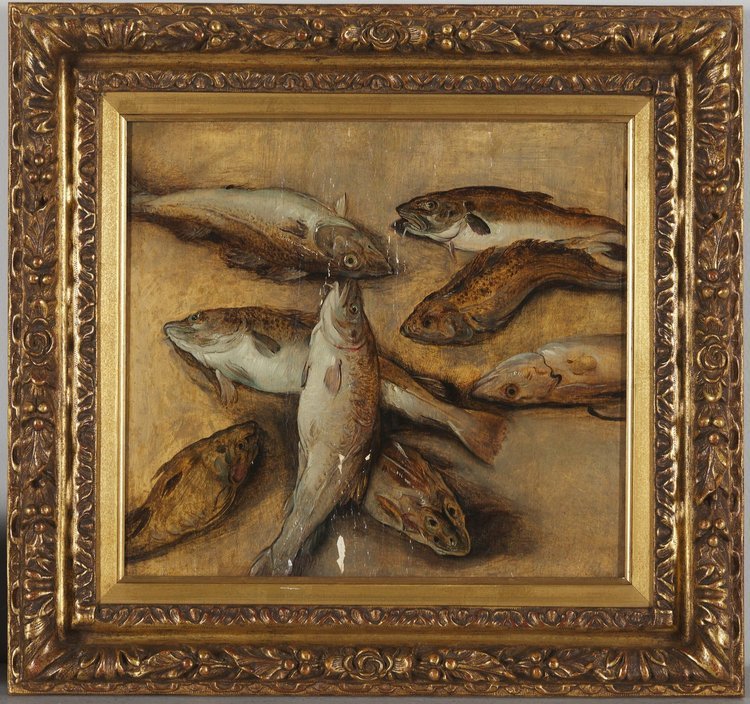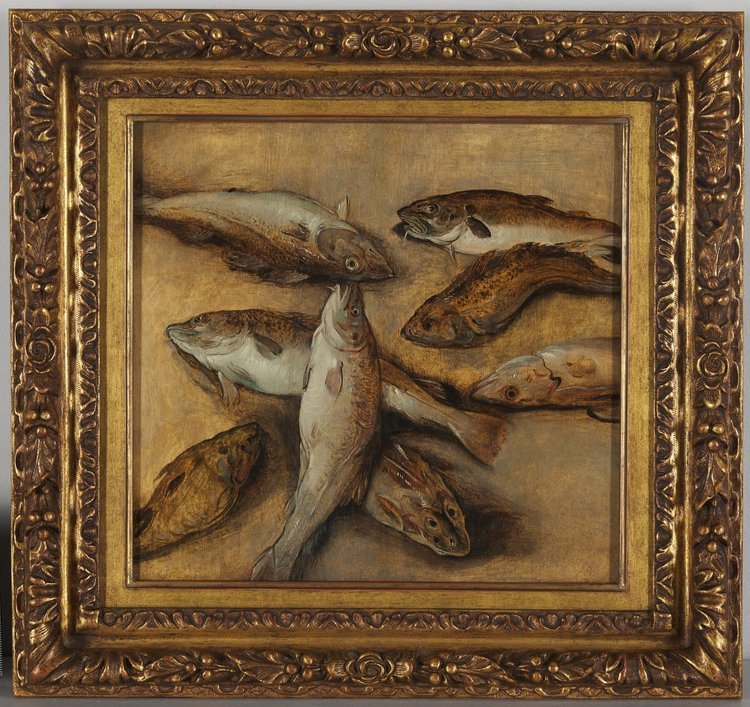Panel paintings are particularly temperamental. Before painting on canvas became popular, paintings were often executed on wood panels. This could be either a single board or panels joined together, often with a grid of wooden slats on the back to provide support called a cradle. This is the case with Etude de Poissons de Mer Panneau. A still-life study of sea fish, this cradled panel painting is attributed to Jan Brueghel the Younger. Brueghel was a Flemish painter, who lived from 1601-1678, placing this painting from the 17th century and approximately 400 years old. The current owner's father purchased the painting years ago, who loves this painting "because of the skill of painters at that time ... plus this painting is by the grandson of the great Pieter Bruegel the Elder!"
Etude de Poissons de Mer Panneau before treatment
Etude de Poissons de Mer Panneau before treatment, verso
Upon arrival at The Center, Etude de Poissons de Mer Panneau exhibited condition issues consistent with age. The painting is executed on a 1/4" panel with a vertical wood grain and is cradled. The painting appears slightly convex when viewed from the front. Two labels were present on the back, one on the verso of the painting and one on the verso of the frame. Consistent with the age and construction, age-related micro-cracking was present throughout the paint layer due to the movement of the wood grain over time. However, the cracking appeared to be stable at the time of examination.
Etude de Poissons de Mer Panneau before treatment under raking light
An area of tenting paint was found in the lower left quadrant, and small losses were noted along the area of tenting paint. There were two more considerable losses at the bottom center, measuring approximately 1/2" by 1/2" and 1 1/4" by 1/4".
Etude de Poissons de Mer Panneau before treatment, detail
Etude de Poissons de Mer Panneau before treatment, detail
The examination also revealed extensive previous retouching along the painting's bottom 1" and top 3" and along areas of flaking paint. The previous repaint corresponds to areas now flaking. The areas of the previous repaint still matched the surrounding paint acceptably. The fill material used had not been moving with the wood grain to the same extent as the original paint layer; however, this is to conservation standards and is expected in the treatment of panel paintings. Conservators always want the repair to be weaker than the original material, so it will fail if there are structural fluctuations. The painting appeared to have been varnished with synthetic varnish and exhibited a light layer of surface grime.
Etude de Poissons de Mer Panneau before treatment, under UV light examination
Etude de Poissons de Mer Panneau before treatment, under UV light examination
The frame comprises of wood, gesso, toner, red bole, and gold leaf. The frame's finish appeared original and intentionally distressed, and a minimal layer of surface grime was noted on the surface. Minor scratches to the lower right center of the liner of the frame were noted during the examination, and there were also minor losses to the gesso and gilding at the lower proper left miter.
Detail of frame before treatment
Rebecca Vodehnal, Associate Paintings Conservator, began treatment by addressing the flaking paint. To stabilize the tenting and flaking paint, Rebecca consolidated the paint layer locally using conservation adhesives. Once stable, the paint layer could be surface cleaned to remove any grime from the surface, and the reverse was then cleaned using a soft brush and vacuum. This process is particularly time-consuming with cradle paintings, as cradled paintings often gather dust, grime, and other particulates on the many surfaces created by the cradle's crossbars.
Etude de Poissons de Mer Panneau during treatment under UV light
As the areas of previous repainting was not discolored, it was left in place. Losses were filled and textured using appropriate conservation-grade fill material. Inpainting was then carried out in the areas of loss and abrasion using reversible conservation paints to emulate the surrounding areas. A final coat of varnish was then applied to integrate the surface gloss.
Etude de Poissons de Mer Panneau after treatment, unframed
Etude de Poissons de Mer Panneau after treatment, unframed verso
The losses to the gilding and gesso of the frame were consolidated using conservation adhesive by Senior Conservator of Furniture Stephen Ryan, before the frame was cleaned to remove the surface grime. Losses and scratches were inpainted to emulate the surrounding surface. However, aside from the minimal impainting and a protective layer of wax, the frame's finish was left in its present state.
The painting is too small at the top right edge of the frame opening, showing the panel's edge. Since only 1/16" of the panel was engaging on the left and right sides, a new custom liner was fabricated to better secure the painting in the frame. The liner features an antique gold finish to match the frame's finish as closely as possible. Now reinstalled in the existing frame, Etude de Poissons de Mer Panneau is secure and ready to be back on display.
Etude de Poissons de Mer Panneau after treatment
Etude de Poissons de Mer Panneau after treatment















